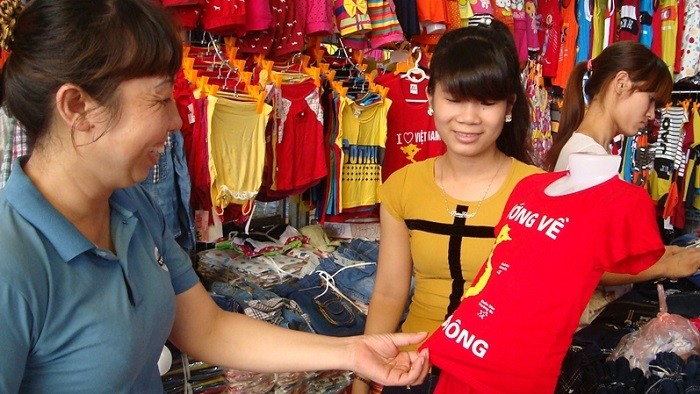Conquering domestic market
Difficulties from the shortage of raw materials in the first moths and the lack of export orders in the middle months this year caused the revenue of Nam Dinh Textile and Garment Corporation to plummet in the first half of 2020. Right from mid-2020, the corporation has been determined to return to conquer the domestic market, considering it an important market segment to offset revenue losses due to COVID-19.
Nguyen Van Mieng, the corporation’s general director, said that for the fibre segment, prior to the pandemic, his corporation produced 1,100 tonnes, of which 600 tonnes were exported, which means the proportion of exports was up to 65%. Now that figure is down to 45%. The company is compensating for that shortage by expanding its activities in the domestic market. In terms of fabric, the corporation is currently producing about 1.2 million metres a month. By the third and fourth quarter this year, the production is likely to see a decrease of about 230,000-300,000 metres. Therefore, the corporation has decided to expand its consumption market to the Northern provinces towards offering new product lines in taking advantage from its dyed fabrics to supply garment companies.
“In particular, we improve the linkage within the yarn-weaving-dyeing chain so that all units in the chain have orders for stability and development, from which we would approach the corporation's set target for revenue this year, although we are suffering losses in the first half,” said Mieng.
Along with Nam Dinh Textile and Garment, many other enterprises in the sector have also timely shifted to the domestic market amid the difficulties in their exports. Le Tien Truong, Deputy General Director of Vietnam National Textile and Garment Group, said that with the specificity of the labour-intensive industry, the loss of many orders in the first months of the year had a huge negative impact on the revenues of businesses and jobs of workers. Therefore, redirecting to the domestic market is an important solution to offset the loss revenue. Although revenue from the domestic market still accounts for a small proportion (about 10% of the industry's capacity), making it not the sole solution to create jobs for workers, it still needs to be considered as a solution to reassure employees and encourage them in active production, as well as to promote the use of Vietnamese products among the public. Besides, the good exploitation of the domestic market also has the positive effect of helping businesses solve the issue related to raw materials and reducing dependence on imports from abroad.
In fact, the domestic market with a population of nearly 100 million people is considered a potential market for domestic textile enterprises. According to the Vietnam Textile and Apparel Association (VITAS), the domestic consumption of textiles and garments is currently worth about US$3.5-4 billion.
As for fashion clothing, due to increasing demand in the domestic market, Vietnam has attracted many international enterprises with strong finance and global distribution systems. Currently, more than 200 foreign brands are present in the domestic market, providing mid to high-end products. Well-known brands like Zara, H&M and Uniqlo have enjoyed turnover of trillions of VND per year since their first steps in Vietnam.
For domestic textile enterprises, for many years, they have continuously invested in and boosted production of various product lines to supply to the domestic market. Some businesses have developed products, services and brands with increasingly high quality and reasonable prices, thus better meeting the production and consumption needs of the domestic market while forming a distribution system nationwide.
Along with the snow-ball effect from promoting domestic consumption, Vietnamese textile and garment products have increasingly conquered consumers. However, the weakness of Vietnam's textile products is that they are not diverse in serving different market segments, while their prices are also not very attractive. They are mostly strong in the mid-range segment in products such as office shirts, uniforms and workwear.
Focusing on the right segments
A series of free trade agreements (FTAs), especially the Vietnam - EU FTA that just come into effect from this August, have not only opened the door for Vietnamese goods abroad but also have created conditions for foreign goods and products to flood into Vietnam. With diversity in the recognised brands and segments, this will directly affect consumption of locally made products by Vietnamese enterprises.
According to Truong Van Cam, VISTA Vice Chairman, although Vietnamese enterprises has been successful in exporting, doing business at home is still difficult for them.
The reason is that when operating in the domestic market, local enterprises must produce, build distribution systems, and plan other sales and marketing campaigns, rather only focusing on fulfilling shipments for export. However, in the current difficult export context, the effective access to the domestic market is an urgent matter.
Local businesses have been suggested to build a distribution network. Especially, small-sized businesses should be more active in conquering domestic consumers by investing in design, increasing product quality, and restructuring costs towards a more suitable price for their products. At the same time, businesses need to standardise their views and methods of serving customers, as well as catching up with fashion trends around the world to take responsibility for their products and win customers' trust.
In addition, it is necessary to build industrial zones with wastewater treatment and call for investment in combined factories covering all yarn - weaving - dyeing processes in order to complete the chain of production for fabric materials, thus better serving the textile and garment industry. This will also be the basis for increased localisation of fabric materials, laying the foundation for the textile industry to change production from processing to active designing and production, serving both domestic consumption and stronger export of Vietnamese garment products post COVID-19.
















